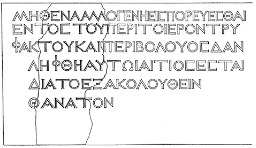It feels like a long time since my Turkey trip in March 2017. I took about 6500 photos from my study tour through Turkey. A big shout-out to Dr. Mark Wilson who was an amazing commentator for connecting the archaeology and landscape of the sites I visited with the history of early Christianity in Asia Minor. Many thanks also to Tuktu Tours who organized the trip (as safe as safe could be!) and Meltem Ciftci, our official tour guide.
This post is on the Istanbul National Museum because I was able to finally connect one archaeological find in the Israel Museum, of which I took photos back in April 2016, to another artefact housed in Istanbul. First is the inscription from the Israel National Museum which was found near the Lion’s Gate of old Jerusalem:
| Greek Temple Mount Warning (Israel Museum) Photo by Max Lee ©2016 |
This small inscription currently housed in Jerusalem is so fragmentary, it’s hard to figure out what it might say. None of what you see is a full word except for a random article (τοῦ) or conjunction (καί). Here is the inscription again in transcribed form:
- ΘΕΝΑΑΛΛ
- ΤΟΣΤΟΥΠ
- ΤΟΥΚΑΙ
- ΗΦΘΗΑΥ
- ΙΑΤΟΕΞ
- ΘΑΝΑΤ
Josephus writes about a series of stone slabs that give warnings to foreigners, some written in Greek, others Latin, that no foreigner was permitted to enter the Temple area (see Jewish Wars 5.194). Scholars rightly identify the above inscription as an example of this warning.
But the identification is only possible because we can compare it to a larger and more complete warning which was found north of the Temple Mount and is currently housed at the Istanbul National Museum (how a fragment unearthed at the Temple Mount finds its way to Istanbul is another story).
Surprisingly, unlike the smaller one above that was protected in a (fiber)glass casing in prominent display, this larger and arguably more important find was on the floor of the Istanbul Museum, sandwiched obscurely between two other displays, without any protection, and vulnerable to the goodwill of any observer who walks by it. It was a first for me to be so close to, and able to touch, an inscription of such importance.
 |
| Companion and More Complete Inscription of the Greek Temple Warning 1st century C.E., located at the Istanbul National Museum Photo by Max Lee ©2017 |
As you can see, the larger inscription is likely complete. For comparison, you can see where the lettering preserved in the 1st inscription (red font) is repeated in its 2nd companion copy:
- MHΘΕΝΑΑΛΛΟΓΕΝΗΕΙΣΠΟ
- ΡΕΥΕΣΘΑΙΕΝΤΟΣΤΟΥΠΕ
- PΙΤΟΙΕΡΟΝΤΡΥΦΑΚΤΟΥΚΑΙ
- ΠΕΡΙΒΟΛΟΥΟΣΔΑΝΛΗ
- ΦΘΗΕΑΥΤΩΙΑΙΤΙΟΣΕΣ
- ΤΑΙΔΙΑΤΟΕΞΑΚΟΛΟΥ
- ΘΕΙΝΘΑΝΑΤΟΝ
Put the inscription in cursive text with an English translation, and it reads:
μηθένα ἀλλογενῆ εἰσπο|ρεύσθαι ἐντὸς τοῦ πε|ρὶ τὸ ἱερον τρυφάκτου καὶ | περιβόλου. ὅς δ’ ἂν ληφθῇ ἑαυτῷ αἴτιος ἔσ|ται διὰ τὸ ἐξακολου|θεῖν θάνατον
No foreigner is to enter within the balustrade and enclosed area surrounding the Temple. And whosoever is caught will himself be responsible for his resultant death
With this full inscription from the 2nd artefact, we can now reconstruct what the 1st smaller inscription must have looked like as a companion copy of the same warning. Below is an artists’s reconstruction of the 1st inscription in its entirety as the script is extrapolated from the original piece (traced out below).
 |
| Diagram from Corpus Inscriptionum Iudaeae Palestinae (vol. 1, pt 1; p. 43) |
As Josephus stated (“In this [balustrade] at regular intervals stood slabs giving warning, some in Greek, others in Latin characters, of the law of purification, to wit that no foreigner was permitted to enter the holy place, for so the second enclosure of the temple was called” J.W. 5.194; LCL, p. 61), there were several such warning signs all over the temple area. Luckily, we have at least two of them.
The signs give a historical context to several texts in the New Testament, including the scene in Acts where some pious Jews thought Paul had brought a Gentile, Trophimus the Ephesian (Acts 21:29), into the temple, and started a riot as a result. There is also Paul’s reference to the temple’s physical walls separating out the court of the men from foreigners in the Letter to the Ephesians. Here he uses it as a metaphor for how this “dividing wall of hostility” between Jews and Gentiles has been torn down by the work of Christ (e.g., Eph. 2:14).
You must be logged in to post a comment.